Applying Theories, Principles, and Models in Education and Training
VerifiedAdded on 2023/06/17
|22
|7919
|323
Report
AI Summary
This report provides a comprehensive analysis of various theories, principles, and models in education and training. It begins by exploring learning theories such as behaviorism, constructivism, and cognitivism, and their applications in teaching, learning, and assessment. The report further analyzes models of learning preference, including the VARK model and Henry Mumford's learning styles, emphasizing the importance of inclusive teaching. Communication theories, such as the Shannon and Weaver model, and their verbal and non-verbal applications in teaching are also examined. The report delves into assessment theories and their practical application in evaluating learning. Furthermore, it analyzes theories and models of curriculum development, focusing on their implementation in business studies and management, the specialist area. Finally, the report explores theories and models of reflection and evaluation, applying them to review personal teaching practices, concluding with a summary of key findings and their implications for educators.
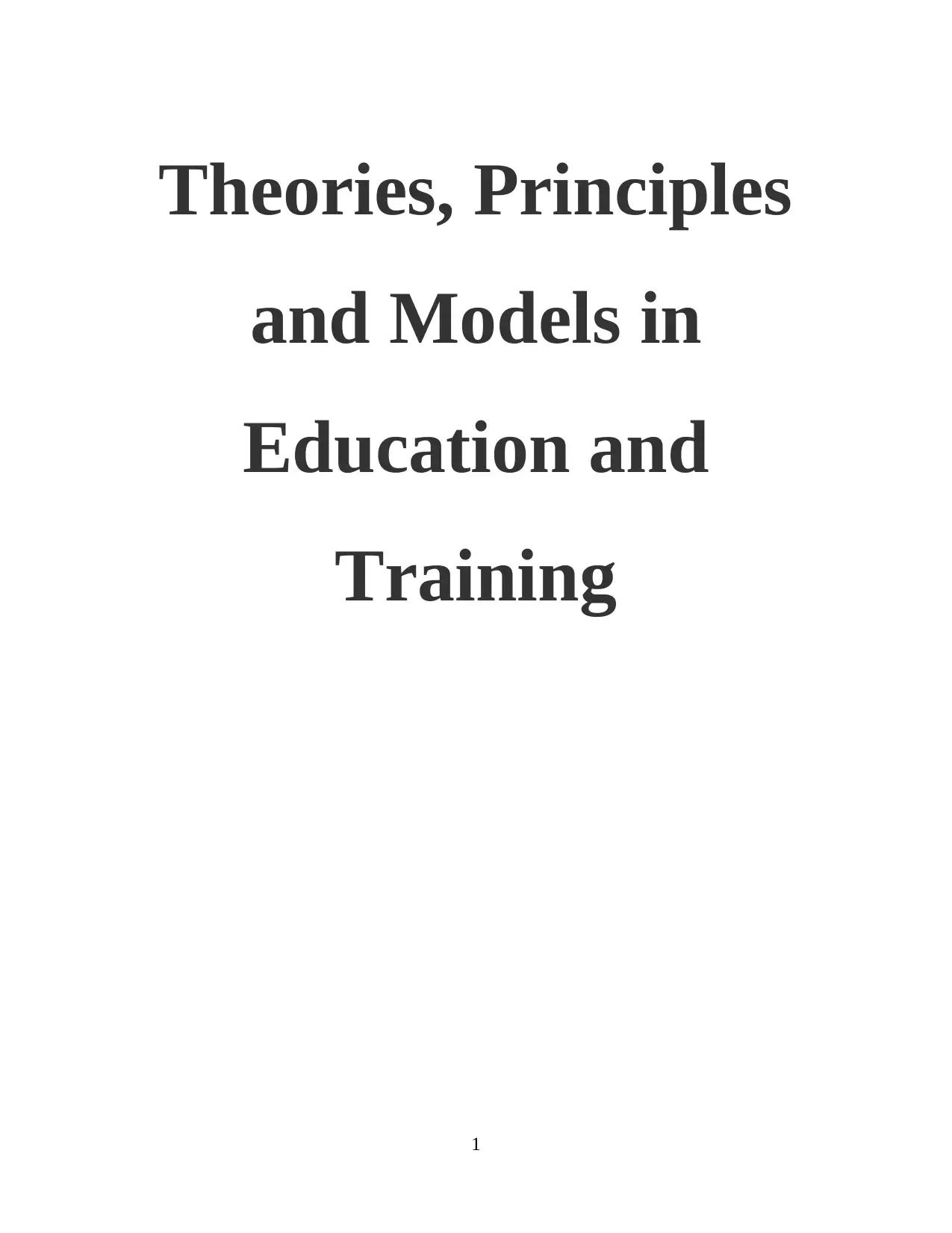
Theories, Principles
and Models in
Education and
Training
1
and Models in
Education and
Training
1
Paraphrase This Document
Need a fresh take? Get an instant paraphrase of this document with our AI Paraphraser
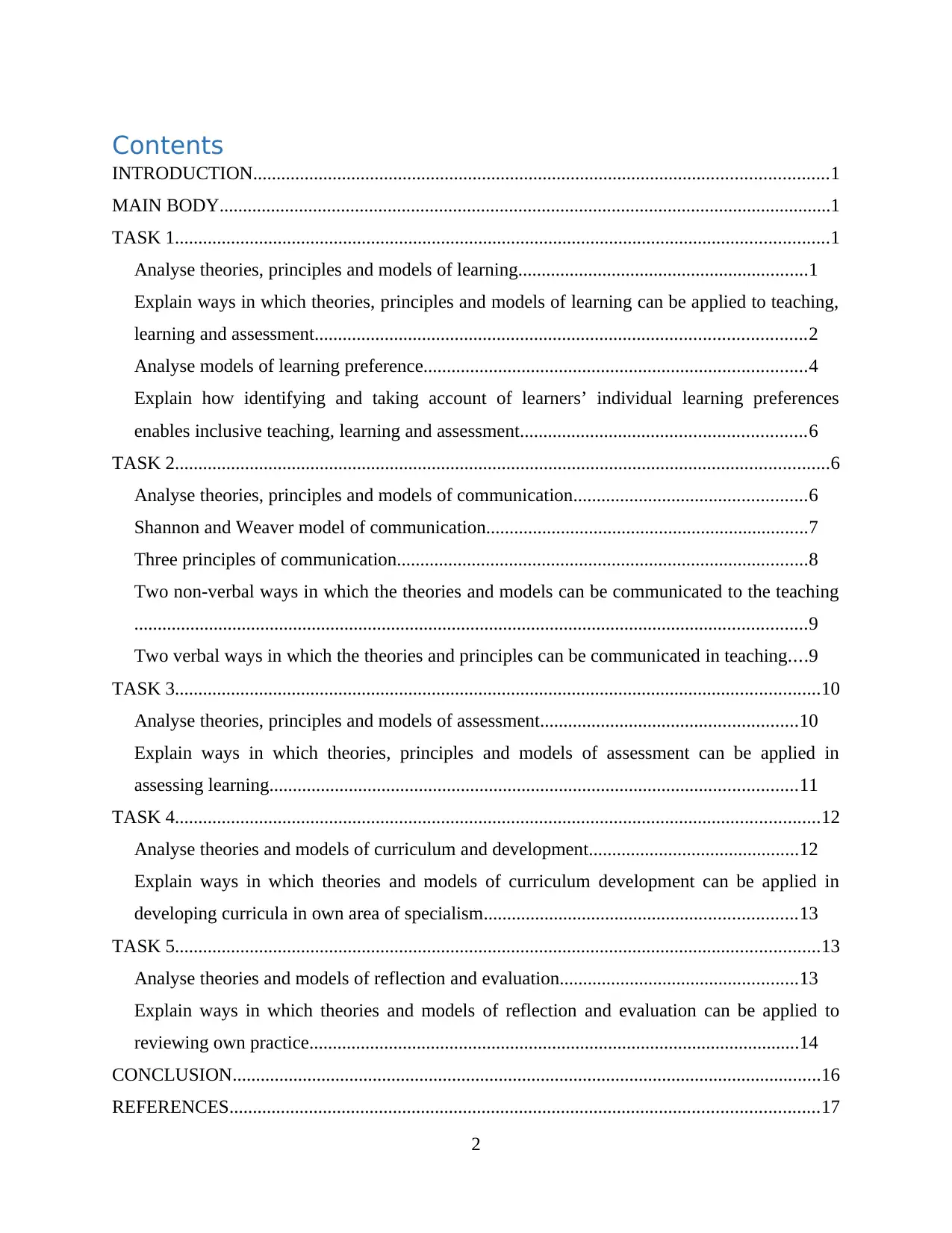
Contents
INTRODUCTION...........................................................................................................................1
MAIN BODY...................................................................................................................................1
TASK 1............................................................................................................................................1
Analyse theories, principles and models of learning..............................................................1
Explain ways in which theories, principles and models of learning can be applied to teaching,
learning and assessment.........................................................................................................2
Analyse models of learning preference..................................................................................4
Explain how identifying and taking account of learners’ individual learning preferences
enables inclusive teaching, learning and assessment.............................................................6
TASK 2............................................................................................................................................6
Analyse theories, principles and models of communication..................................................6
Shannon and Weaver model of communication.....................................................................7
Three principles of communication........................................................................................8
Two non-verbal ways in which the theories and models can be communicated to the teaching
................................................................................................................................................9
Two verbal ways in which the theories and principles can be communicated in teaching....9
TASK 3..........................................................................................................................................10
Analyse theories, principles and models of assessment.......................................................10
Explain ways in which theories, principles and models of assessment can be applied in
assessing learning.................................................................................................................11
TASK 4..........................................................................................................................................12
Analyse theories and models of curriculum and development.............................................12
Explain ways in which theories and models of curriculum development can be applied in
developing curricula in own area of specialism...................................................................13
TASK 5..........................................................................................................................................13
Analyse theories and models of reflection and evaluation...................................................13
Explain ways in which theories and models of reflection and evaluation can be applied to
reviewing own practice.........................................................................................................14
CONCLUSION..............................................................................................................................16
REFERENCES..............................................................................................................................17
2
INTRODUCTION...........................................................................................................................1
MAIN BODY...................................................................................................................................1
TASK 1............................................................................................................................................1
Analyse theories, principles and models of learning..............................................................1
Explain ways in which theories, principles and models of learning can be applied to teaching,
learning and assessment.........................................................................................................2
Analyse models of learning preference..................................................................................4
Explain how identifying and taking account of learners’ individual learning preferences
enables inclusive teaching, learning and assessment.............................................................6
TASK 2............................................................................................................................................6
Analyse theories, principles and models of communication..................................................6
Shannon and Weaver model of communication.....................................................................7
Three principles of communication........................................................................................8
Two non-verbal ways in which the theories and models can be communicated to the teaching
................................................................................................................................................9
Two verbal ways in which the theories and principles can be communicated in teaching....9
TASK 3..........................................................................................................................................10
Analyse theories, principles and models of assessment.......................................................10
Explain ways in which theories, principles and models of assessment can be applied in
assessing learning.................................................................................................................11
TASK 4..........................................................................................................................................12
Analyse theories and models of curriculum and development.............................................12
Explain ways in which theories and models of curriculum development can be applied in
developing curricula in own area of specialism...................................................................13
TASK 5..........................................................................................................................................13
Analyse theories and models of reflection and evaluation...................................................13
Explain ways in which theories and models of reflection and evaluation can be applied to
reviewing own practice.........................................................................................................14
CONCLUSION..............................................................................................................................16
REFERENCES..............................................................................................................................17
2
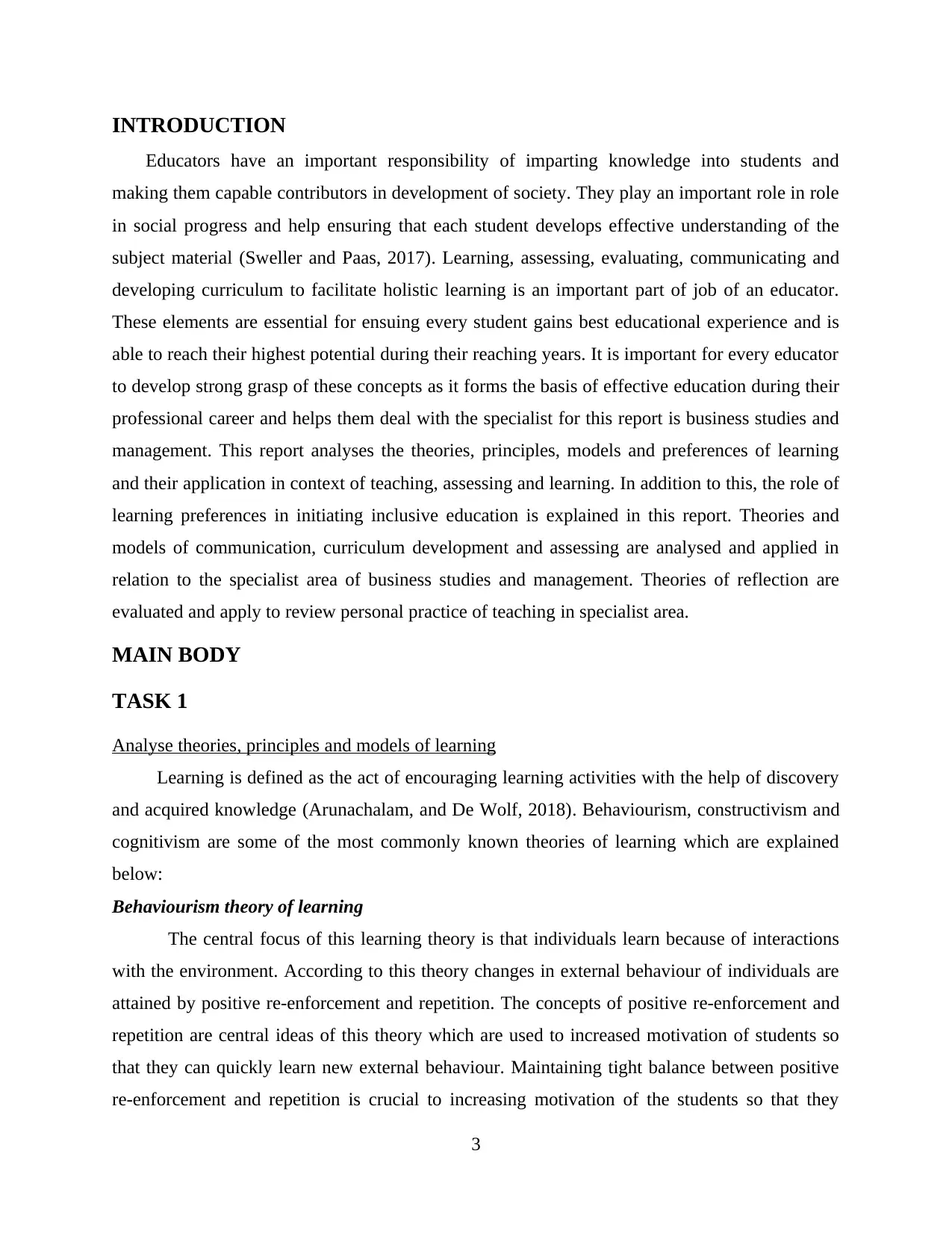
INTRODUCTION
Educators have an important responsibility of imparting knowledge into students and
making them capable contributors in development of society. They play an important role in role
in social progress and help ensuring that each student develops effective understanding of the
subject material (Sweller and Paas, 2017). Learning, assessing, evaluating, communicating and
developing curriculum to facilitate holistic learning is an important part of job of an educator.
These elements are essential for ensuing every student gains best educational experience and is
able to reach their highest potential during their reaching years. It is important for every educator
to develop strong grasp of these concepts as it forms the basis of effective education during their
professional career and helps them deal with the specialist for this report is business studies and
management. This report analyses the theories, principles, models and preferences of learning
and their application in context of teaching, assessing and learning. In addition to this, the role of
learning preferences in initiating inclusive education is explained in this report. Theories and
models of communication, curriculum development and assessing are analysed and applied in
relation to the specialist area of business studies and management. Theories of reflection are
evaluated and apply to review personal practice of teaching in specialist area.
MAIN BODY
TASK 1
Analyse theories, principles and models of learning
Learning is defined as the act of encouraging learning activities with the help of discovery
and acquired knowledge (Arunachalam, and De Wolf, 2018). Behaviourism, constructivism and
cognitivism are some of the most commonly known theories of learning which are explained
below:
Behaviourism theory of learning
The central focus of this learning theory is that individuals learn because of interactions
with the environment. According to this theory changes in external behaviour of individuals are
attained by positive re-enforcement and repetition. The concepts of positive re-enforcement and
repetition are central ideas of this theory which are used to increased motivation of students so
that they can quickly learn new external behaviour. Maintaining tight balance between positive
re-enforcement and repetition is crucial to increasing motivation of the students so that they
3
Educators have an important responsibility of imparting knowledge into students and
making them capable contributors in development of society. They play an important role in role
in social progress and help ensuring that each student develops effective understanding of the
subject material (Sweller and Paas, 2017). Learning, assessing, evaluating, communicating and
developing curriculum to facilitate holistic learning is an important part of job of an educator.
These elements are essential for ensuing every student gains best educational experience and is
able to reach their highest potential during their reaching years. It is important for every educator
to develop strong grasp of these concepts as it forms the basis of effective education during their
professional career and helps them deal with the specialist for this report is business studies and
management. This report analyses the theories, principles, models and preferences of learning
and their application in context of teaching, assessing and learning. In addition to this, the role of
learning preferences in initiating inclusive education is explained in this report. Theories and
models of communication, curriculum development and assessing are analysed and applied in
relation to the specialist area of business studies and management. Theories of reflection are
evaluated and apply to review personal practice of teaching in specialist area.
MAIN BODY
TASK 1
Analyse theories, principles and models of learning
Learning is defined as the act of encouraging learning activities with the help of discovery
and acquired knowledge (Arunachalam, and De Wolf, 2018). Behaviourism, constructivism and
cognitivism are some of the most commonly known theories of learning which are explained
below:
Behaviourism theory of learning
The central focus of this learning theory is that individuals learn because of interactions
with the environment. According to this theory changes in external behaviour of individuals are
attained by positive re-enforcement and repetition. The concepts of positive re-enforcement and
repetition are central ideas of this theory which are used to increased motivation of students so
that they can quickly learn new external behaviour. Maintaining tight balance between positive
re-enforcement and repetition is crucial to increasing motivation of the students so that they
3
⊘ This is a preview!⊘
Do you want full access?
Subscribe today to unlock all pages.

Trusted by 1+ million students worldwide
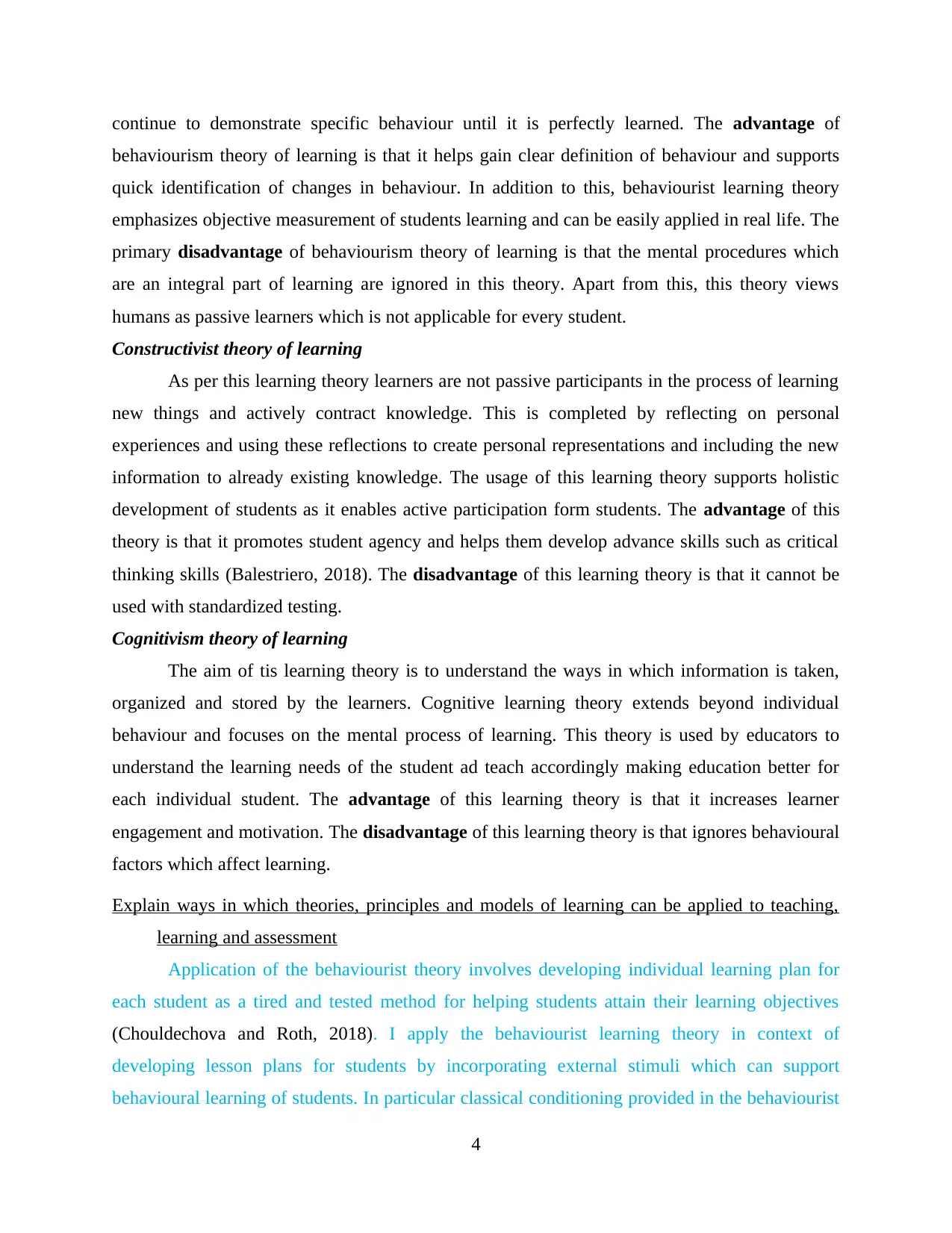
continue to demonstrate specific behaviour until it is perfectly learned. The advantage of
behaviourism theory of learning is that it helps gain clear definition of behaviour and supports
quick identification of changes in behaviour. In addition to this, behaviourist learning theory
emphasizes objective measurement of students learning and can be easily applied in real life. The
primary disadvantage of behaviourism theory of learning is that the mental procedures which
are an integral part of learning are ignored in this theory. Apart from this, this theory views
humans as passive learners which is not applicable for every student.
Constructivist theory of learning
As per this learning theory learners are not passive participants in the process of learning
new things and actively contract knowledge. This is completed by reflecting on personal
experiences and using these reflections to create personal representations and including the new
information to already existing knowledge. The usage of this learning theory supports holistic
development of students as it enables active participation form students. The advantage of this
theory is that it promotes student agency and helps them develop advance skills such as critical
thinking skills (Balestriero, 2018). The disadvantage of this learning theory is that it cannot be
used with standardized testing.
Cognitivism theory of learning
The aim of tis learning theory is to understand the ways in which information is taken,
organized and stored by the learners. Cognitive learning theory extends beyond individual
behaviour and focuses on the mental process of learning. This theory is used by educators to
understand the learning needs of the student ad teach accordingly making education better for
each individual student. The advantage of this learning theory is that it increases learner
engagement and motivation. The disadvantage of this learning theory is that ignores behavioural
factors which affect learning.
Explain ways in which theories, principles and models of learning can be applied to teaching,
learning and assessment
Application of the behaviourist theory involves developing individual learning plan for
each student as a tired and tested method for helping students attain their learning objectives
(Chouldechova and Roth, 2018). I apply the behaviourist learning theory in context of
developing lesson plans for students by incorporating external stimuli which can support
behavioural learning of students. In particular classical conditioning provided in the behaviourist
4
behaviourism theory of learning is that it helps gain clear definition of behaviour and supports
quick identification of changes in behaviour. In addition to this, behaviourist learning theory
emphasizes objective measurement of students learning and can be easily applied in real life. The
primary disadvantage of behaviourism theory of learning is that the mental procedures which
are an integral part of learning are ignored in this theory. Apart from this, this theory views
humans as passive learners which is not applicable for every student.
Constructivist theory of learning
As per this learning theory learners are not passive participants in the process of learning
new things and actively contract knowledge. This is completed by reflecting on personal
experiences and using these reflections to create personal representations and including the new
information to already existing knowledge. The usage of this learning theory supports holistic
development of students as it enables active participation form students. The advantage of this
theory is that it promotes student agency and helps them develop advance skills such as critical
thinking skills (Balestriero, 2018). The disadvantage of this learning theory is that it cannot be
used with standardized testing.
Cognitivism theory of learning
The aim of tis learning theory is to understand the ways in which information is taken,
organized and stored by the learners. Cognitive learning theory extends beyond individual
behaviour and focuses on the mental process of learning. This theory is used by educators to
understand the learning needs of the student ad teach accordingly making education better for
each individual student. The advantage of this learning theory is that it increases learner
engagement and motivation. The disadvantage of this learning theory is that ignores behavioural
factors which affect learning.
Explain ways in which theories, principles and models of learning can be applied to teaching,
learning and assessment
Application of the behaviourist theory involves developing individual learning plan for
each student as a tired and tested method for helping students attain their learning objectives
(Chouldechova and Roth, 2018). I apply the behaviourist learning theory in context of
developing lesson plans for students by incorporating external stimuli which can support
behavioural learning of students. In particular classical conditioning provided in the behaviourist
4
Paraphrase This Document
Need a fresh take? Get an instant paraphrase of this document with our AI Paraphraser
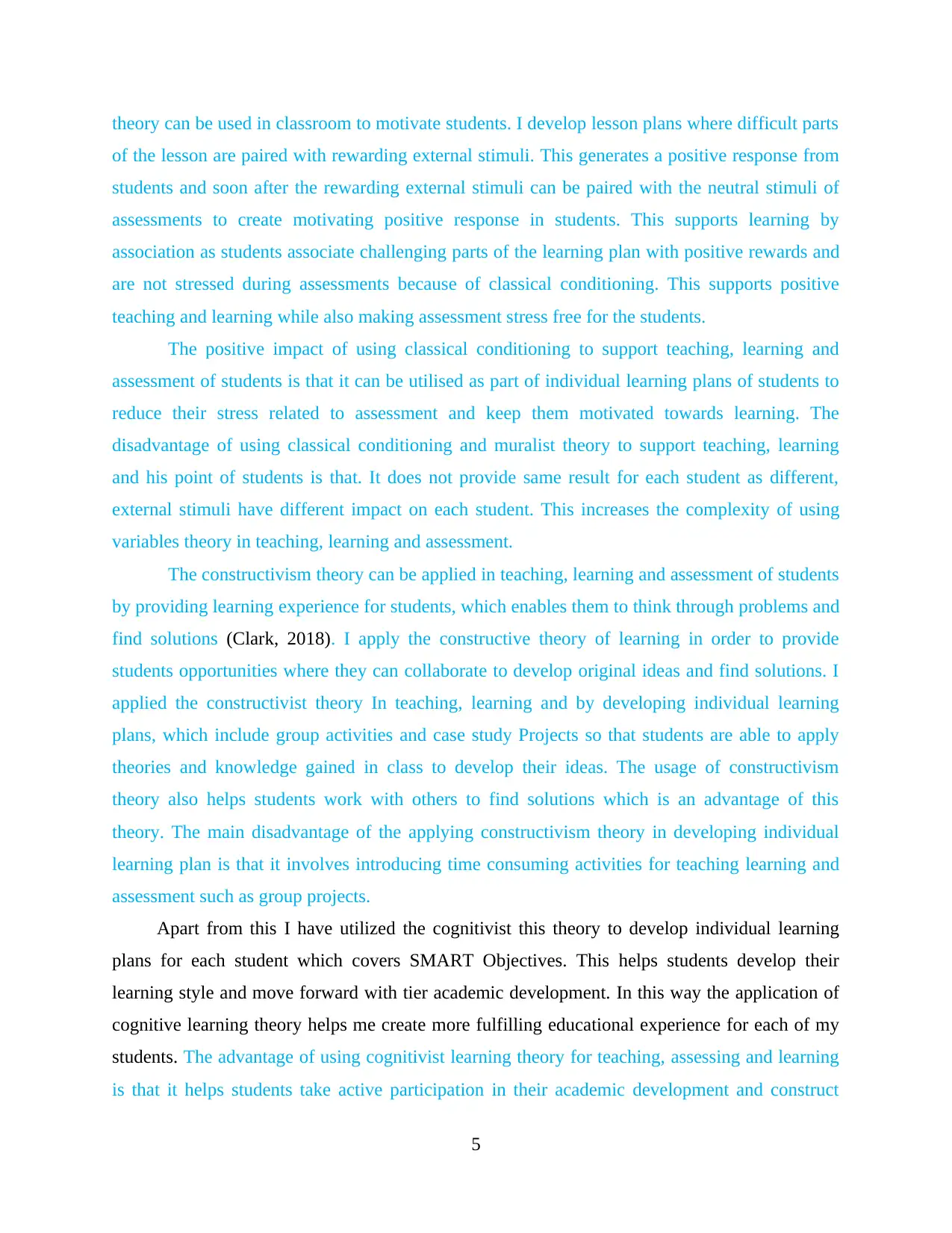
theory can be used in classroom to motivate students. I develop lesson plans where difficult parts
of the lesson are paired with rewarding external stimuli. This generates a positive response from
students and soon after the rewarding external stimuli can be paired with the neutral stimuli of
assessments to create motivating positive response in students. This supports learning by
association as students associate challenging parts of the learning plan with positive rewards and
are not stressed during assessments because of classical conditioning. This supports positive
teaching and learning while also making assessment stress free for the students.
The positive impact of using classical conditioning to support teaching, learning and
assessment of students is that it can be utilised as part of individual learning plans of students to
reduce their stress related to assessment and keep them motivated towards learning. The
disadvantage of using classical conditioning and muralist theory to support teaching, learning
and his point of students is that. It does not provide same result for each student as different,
external stimuli have different impact on each student. This increases the complexity of using
variables theory in teaching, learning and assessment.
The constructivism theory can be applied in teaching, learning and assessment of students
by providing learning experience for students, which enables them to think through problems and
find solutions (Clark, 2018). I apply the constructive theory of learning in order to provide
students opportunities where they can collaborate to develop original ideas and find solutions. I
applied the constructivist theory In teaching, learning and by developing individual learning
plans, which include group activities and case study Projects so that students are able to apply
theories and knowledge gained in class to develop their ideas. The usage of constructivism
theory also helps students work with others to find solutions which is an advantage of this
theory. The main disadvantage of the applying constructivism theory in developing individual
learning plan is that it involves introducing time consuming activities for teaching learning and
assessment such as group projects.
Apart from this I have utilized the cognitivist this theory to develop individual learning
plans for each student which covers SMART Objectives. This helps students develop their
learning style and move forward with tier academic development. In this way the application of
cognitive learning theory helps me create more fulfilling educational experience for each of my
students. The advantage of using cognitivist learning theory for teaching, assessing and learning
is that it helps students take active participation in their academic development and construct
5
of the lesson are paired with rewarding external stimuli. This generates a positive response from
students and soon after the rewarding external stimuli can be paired with the neutral stimuli of
assessments to create motivating positive response in students. This supports learning by
association as students associate challenging parts of the learning plan with positive rewards and
are not stressed during assessments because of classical conditioning. This supports positive
teaching and learning while also making assessment stress free for the students.
The positive impact of using classical conditioning to support teaching, learning and
assessment of students is that it can be utilised as part of individual learning plans of students to
reduce their stress related to assessment and keep them motivated towards learning. The
disadvantage of using classical conditioning and muralist theory to support teaching, learning
and his point of students is that. It does not provide same result for each student as different,
external stimuli have different impact on each student. This increases the complexity of using
variables theory in teaching, learning and assessment.
The constructivism theory can be applied in teaching, learning and assessment of students
by providing learning experience for students, which enables them to think through problems and
find solutions (Clark, 2018). I apply the constructive theory of learning in order to provide
students opportunities where they can collaborate to develop original ideas and find solutions. I
applied the constructivist theory In teaching, learning and by developing individual learning
plans, which include group activities and case study Projects so that students are able to apply
theories and knowledge gained in class to develop their ideas. The usage of constructivism
theory also helps students work with others to find solutions which is an advantage of this
theory. The main disadvantage of the applying constructivism theory in developing individual
learning plan is that it involves introducing time consuming activities for teaching learning and
assessment such as group projects.
Apart from this I have utilized the cognitivist this theory to develop individual learning
plans for each student which covers SMART Objectives. This helps students develop their
learning style and move forward with tier academic development. In this way the application of
cognitive learning theory helps me create more fulfilling educational experience for each of my
students. The advantage of using cognitivist learning theory for teaching, assessing and learning
is that it helps students take active participation in their academic development and construct
5
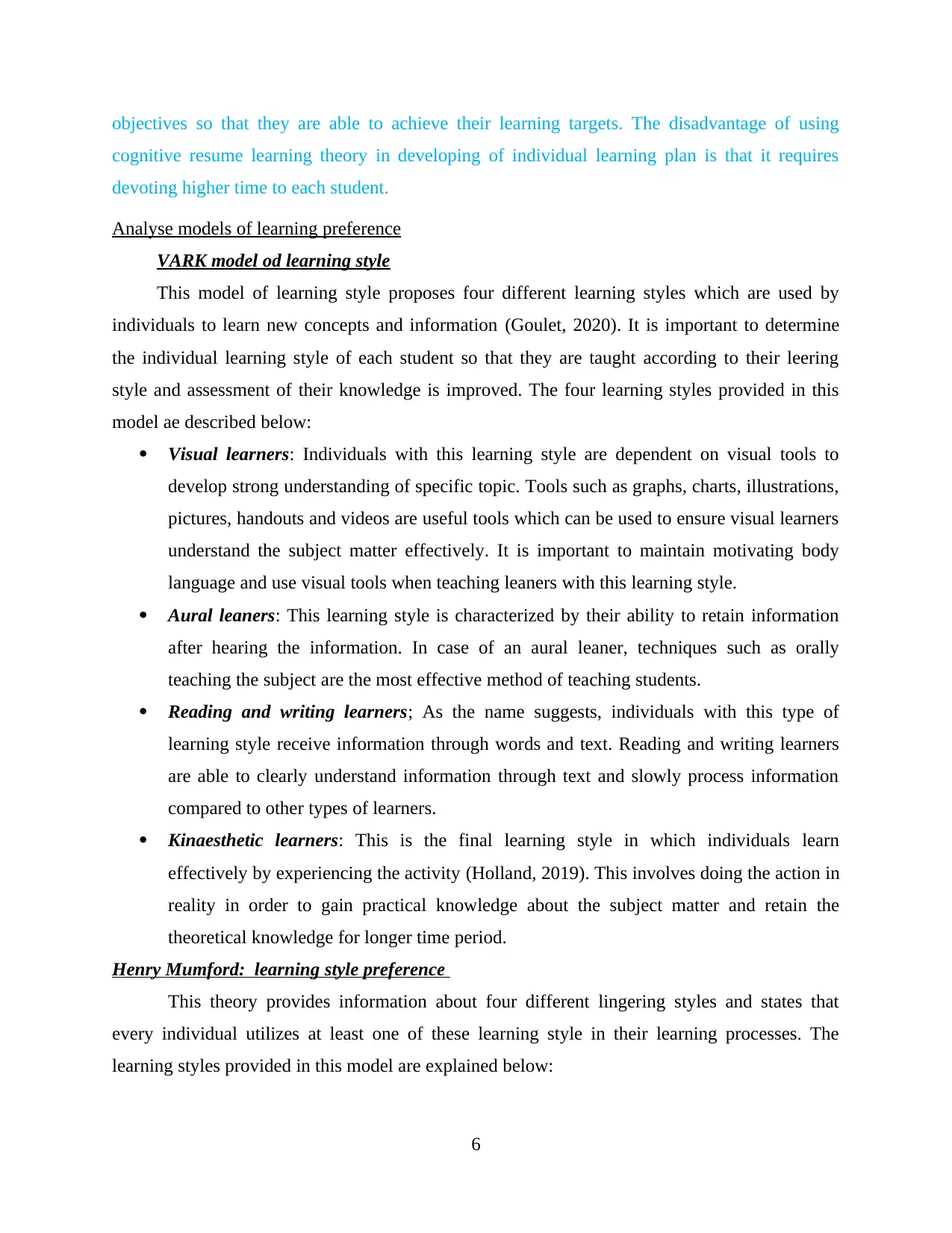
objectives so that they are able to achieve their learning targets. The disadvantage of using
cognitive resume learning theory in developing of individual learning plan is that it requires
devoting higher time to each student.
Analyse models of learning preference
VARK model od learning style
This model of learning style proposes four different learning styles which are used by
individuals to learn new concepts and information (Goulet, 2020). It is important to determine
the individual learning style of each student so that they are taught according to their leering
style and assessment of their knowledge is improved. The four learning styles provided in this
model ae described below:
Visual learners: Individuals with this learning style are dependent on visual tools to
develop strong understanding of specific topic. Tools such as graphs, charts, illustrations,
pictures, handouts and videos are useful tools which can be used to ensure visual learners
understand the subject matter effectively. It is important to maintain motivating body
language and use visual tools when teaching leaners with this learning style.
Aural leaners: This learning style is characterized by their ability to retain information
after hearing the information. In case of an aural leaner, techniques such as orally
teaching the subject are the most effective method of teaching students.
Reading and writing learners; As the name suggests, individuals with this type of
learning style receive information through words and text. Reading and writing learners
are able to clearly understand information through text and slowly process information
compared to other types of learners.
Kinaesthetic learners: This is the final learning style in which individuals learn
effectively by experiencing the activity (Holland, 2019). This involves doing the action in
reality in order to gain practical knowledge about the subject matter and retain the
theoretical knowledge for longer time period.
Henry Mumford: learning style preference
This theory provides information about four different lingering styles and states that
every individual utilizes at least one of these learning style in their learning processes. The
learning styles provided in this model are explained below:
6
cognitive resume learning theory in developing of individual learning plan is that it requires
devoting higher time to each student.
Analyse models of learning preference
VARK model od learning style
This model of learning style proposes four different learning styles which are used by
individuals to learn new concepts and information (Goulet, 2020). It is important to determine
the individual learning style of each student so that they are taught according to their leering
style and assessment of their knowledge is improved. The four learning styles provided in this
model ae described below:
Visual learners: Individuals with this learning style are dependent on visual tools to
develop strong understanding of specific topic. Tools such as graphs, charts, illustrations,
pictures, handouts and videos are useful tools which can be used to ensure visual learners
understand the subject matter effectively. It is important to maintain motivating body
language and use visual tools when teaching leaners with this learning style.
Aural leaners: This learning style is characterized by their ability to retain information
after hearing the information. In case of an aural leaner, techniques such as orally
teaching the subject are the most effective method of teaching students.
Reading and writing learners; As the name suggests, individuals with this type of
learning style receive information through words and text. Reading and writing learners
are able to clearly understand information through text and slowly process information
compared to other types of learners.
Kinaesthetic learners: This is the final learning style in which individuals learn
effectively by experiencing the activity (Holland, 2019). This involves doing the action in
reality in order to gain practical knowledge about the subject matter and retain the
theoretical knowledge for longer time period.
Henry Mumford: learning style preference
This theory provides information about four different lingering styles and states that
every individual utilizes at least one of these learning style in their learning processes. The
learning styles provided in this model are explained below:
6
⊘ This is a preview!⊘
Do you want full access?
Subscribe today to unlock all pages.

Trusted by 1+ million students worldwide
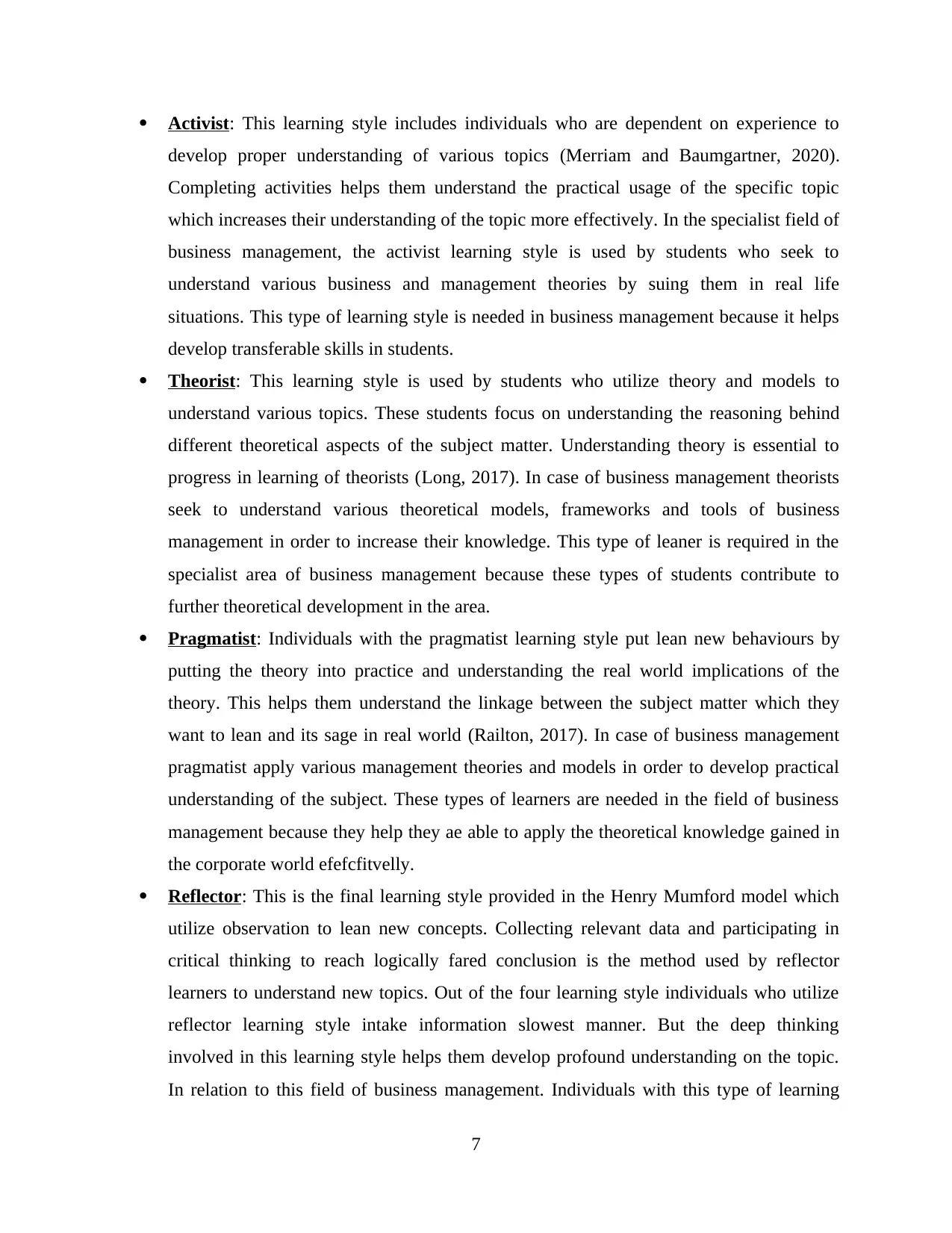
Activist: This learning style includes individuals who are dependent on experience to
develop proper understanding of various topics (Merriam and Baumgartner, 2020).
Completing activities helps them understand the practical usage of the specific topic
which increases their understanding of the topic more effectively. In the specialist field of
business management, the activist learning style is used by students who seek to
understand various business and management theories by suing them in real life
situations. This type of learning style is needed in business management because it helps
develop transferable skills in students.
Theorist: This learning style is used by students who utilize theory and models to
understand various topics. These students focus on understanding the reasoning behind
different theoretical aspects of the subject matter. Understanding theory is essential to
progress in learning of theorists (Long, 2017). In case of business management theorists
seek to understand various theoretical models, frameworks and tools of business
management in order to increase their knowledge. This type of leaner is required in the
specialist area of business management because these types of students contribute to
further theoretical development in the area.
Pragmatist: Individuals with the pragmatist learning style put lean new behaviours by
putting the theory into practice and understanding the real world implications of the
theory. This helps them understand the linkage between the subject matter which they
want to lean and its sage in real world (Railton, 2017). In case of business management
pragmatist apply various management theories and models in order to develop practical
understanding of the subject. These types of learners are needed in the field of business
management because they help they ae able to apply the theoretical knowledge gained in
the corporate world efefcfitvelly.
Reflector: This is the final learning style provided in the Henry Mumford model which
utilize observation to lean new concepts. Collecting relevant data and participating in
critical thinking to reach logically fared conclusion is the method used by reflector
learners to understand new topics. Out of the four learning style individuals who utilize
reflector learning style intake information slowest manner. But the deep thinking
involved in this learning style helps them develop profound understanding on the topic.
In relation to this field of business management. Individuals with this type of learning
7
develop proper understanding of various topics (Merriam and Baumgartner, 2020).
Completing activities helps them understand the practical usage of the specific topic
which increases their understanding of the topic more effectively. In the specialist field of
business management, the activist learning style is used by students who seek to
understand various business and management theories by suing them in real life
situations. This type of learning style is needed in business management because it helps
develop transferable skills in students.
Theorist: This learning style is used by students who utilize theory and models to
understand various topics. These students focus on understanding the reasoning behind
different theoretical aspects of the subject matter. Understanding theory is essential to
progress in learning of theorists (Long, 2017). In case of business management theorists
seek to understand various theoretical models, frameworks and tools of business
management in order to increase their knowledge. This type of leaner is required in the
specialist area of business management because these types of students contribute to
further theoretical development in the area.
Pragmatist: Individuals with the pragmatist learning style put lean new behaviours by
putting the theory into practice and understanding the real world implications of the
theory. This helps them understand the linkage between the subject matter which they
want to lean and its sage in real world (Railton, 2017). In case of business management
pragmatist apply various management theories and models in order to develop practical
understanding of the subject. These types of learners are needed in the field of business
management because they help they ae able to apply the theoretical knowledge gained in
the corporate world efefcfitvelly.
Reflector: This is the final learning style provided in the Henry Mumford model which
utilize observation to lean new concepts. Collecting relevant data and participating in
critical thinking to reach logically fared conclusion is the method used by reflector
learners to understand new topics. Out of the four learning style individuals who utilize
reflector learning style intake information slowest manner. But the deep thinking
involved in this learning style helps them develop profound understanding on the topic.
In relation to this field of business management. Individuals with this type of learning
7
Paraphrase This Document
Need a fresh take? Get an instant paraphrase of this document with our AI Paraphraser
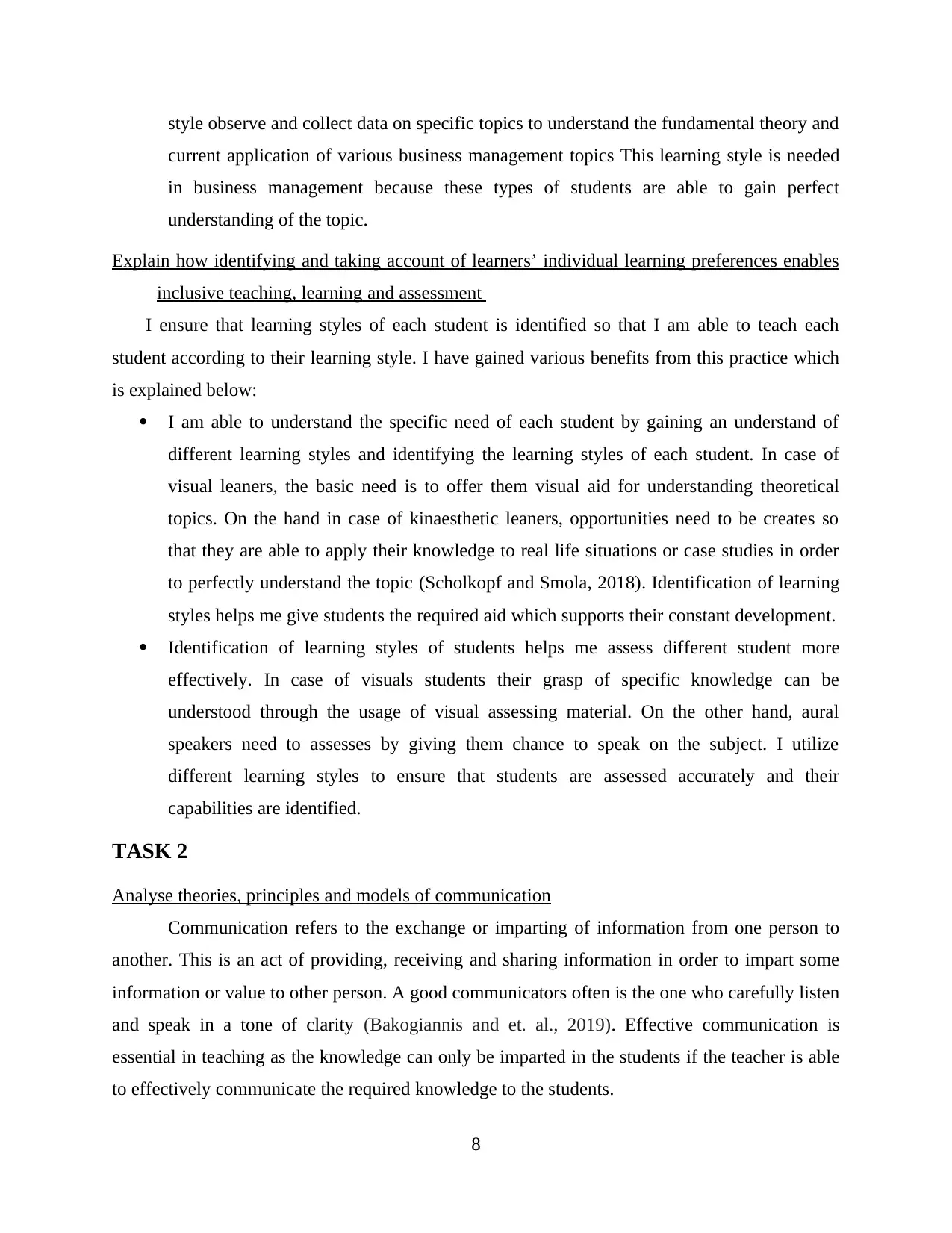
style observe and collect data on specific topics to understand the fundamental theory and
current application of various business management topics This learning style is needed
in business management because these types of students are able to gain perfect
understanding of the topic.
Explain how identifying and taking account of learners’ individual learning preferences enables
inclusive teaching, learning and assessment
I ensure that learning styles of each student is identified so that I am able to teach each
student according to their learning style. I have gained various benefits from this practice which
is explained below:
I am able to understand the specific need of each student by gaining an understand of
different learning styles and identifying the learning styles of each student. In case of
visual leaners, the basic need is to offer them visual aid for understanding theoretical
topics. On the hand in case of kinaesthetic leaners, opportunities need to be creates so
that they are able to apply their knowledge to real life situations or case studies in order
to perfectly understand the topic (Scholkopf and Smola, 2018). Identification of learning
styles helps me give students the required aid which supports their constant development.
Identification of learning styles of students helps me assess different student more
effectively. In case of visuals students their grasp of specific knowledge can be
understood through the usage of visual assessing material. On the other hand, aural
speakers need to assesses by giving them chance to speak on the subject. I utilize
different learning styles to ensure that students are assessed accurately and their
capabilities are identified.
TASK 2
Analyse theories, principles and models of communication
Communication refers to the exchange or imparting of information from one person to
another. This is an act of providing, receiving and sharing information in order to impart some
information or value to other person. A good communicators often is the one who carefully listen
and speak in a tone of clarity (Bakogiannis and et. al., 2019). Effective communication is
essential in teaching as the knowledge can only be imparted in the students if the teacher is able
to effectively communicate the required knowledge to the students.
8
current application of various business management topics This learning style is needed
in business management because these types of students are able to gain perfect
understanding of the topic.
Explain how identifying and taking account of learners’ individual learning preferences enables
inclusive teaching, learning and assessment
I ensure that learning styles of each student is identified so that I am able to teach each
student according to their learning style. I have gained various benefits from this practice which
is explained below:
I am able to understand the specific need of each student by gaining an understand of
different learning styles and identifying the learning styles of each student. In case of
visual leaners, the basic need is to offer them visual aid for understanding theoretical
topics. On the hand in case of kinaesthetic leaners, opportunities need to be creates so
that they are able to apply their knowledge to real life situations or case studies in order
to perfectly understand the topic (Scholkopf and Smola, 2018). Identification of learning
styles helps me give students the required aid which supports their constant development.
Identification of learning styles of students helps me assess different student more
effectively. In case of visuals students their grasp of specific knowledge can be
understood through the usage of visual assessing material. On the other hand, aural
speakers need to assesses by giving them chance to speak on the subject. I utilize
different learning styles to ensure that students are assessed accurately and their
capabilities are identified.
TASK 2
Analyse theories, principles and models of communication
Communication refers to the exchange or imparting of information from one person to
another. This is an act of providing, receiving and sharing information in order to impart some
information or value to other person. A good communicators often is the one who carefully listen
and speak in a tone of clarity (Bakogiannis and et. al., 2019). Effective communication is
essential in teaching as the knowledge can only be imparted in the students if the teacher is able
to effectively communicate the required knowledge to the students.
8
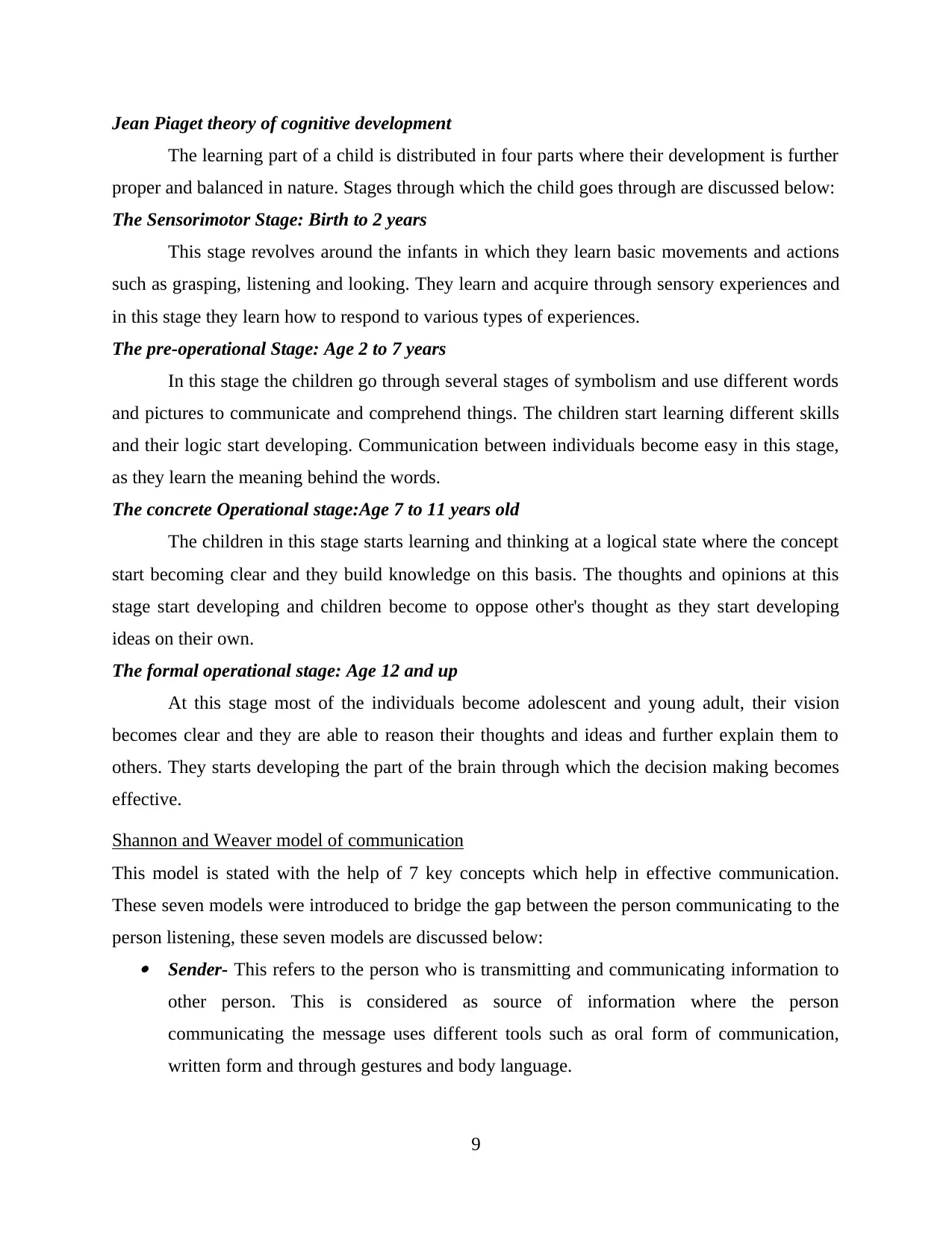
Jean Piaget theory of cognitive development
The learning part of a child is distributed in four parts where their development is further
proper and balanced in nature. Stages through which the child goes through are discussed below:
The Sensorimotor Stage: Birth to 2 years
This stage revolves around the infants in which they learn basic movements and actions
such as grasping, listening and looking. They learn and acquire through sensory experiences and
in this stage they learn how to respond to various types of experiences.
The pre-operational Stage: Age 2 to 7 years
In this stage the children go through several stages of symbolism and use different words
and pictures to communicate and comprehend things. The children start learning different skills
and their logic start developing. Communication between individuals become easy in this stage,
as they learn the meaning behind the words.
The concrete Operational stage:Age 7 to 11 years old
The children in this stage starts learning and thinking at a logical state where the concept
start becoming clear and they build knowledge on this basis. The thoughts and opinions at this
stage start developing and children become to oppose other's thought as they start developing
ideas on their own.
The formal operational stage: Age 12 and up
At this stage most of the individuals become adolescent and young adult, their vision
becomes clear and they are able to reason their thoughts and ideas and further explain them to
others. They starts developing the part of the brain through which the decision making becomes
effective.
Shannon and Weaver model of communication
This model is stated with the help of 7 key concepts which help in effective communication.
These seven models were introduced to bridge the gap between the person communicating to the
person listening, these seven models are discussed below: Sender- This refers to the person who is transmitting and communicating information to
other person. This is considered as source of information where the person
communicating the message uses different tools such as oral form of communication,
written form and through gestures and body language.
9
The learning part of a child is distributed in four parts where their development is further
proper and balanced in nature. Stages through which the child goes through are discussed below:
The Sensorimotor Stage: Birth to 2 years
This stage revolves around the infants in which they learn basic movements and actions
such as grasping, listening and looking. They learn and acquire through sensory experiences and
in this stage they learn how to respond to various types of experiences.
The pre-operational Stage: Age 2 to 7 years
In this stage the children go through several stages of symbolism and use different words
and pictures to communicate and comprehend things. The children start learning different skills
and their logic start developing. Communication between individuals become easy in this stage,
as they learn the meaning behind the words.
The concrete Operational stage:Age 7 to 11 years old
The children in this stage starts learning and thinking at a logical state where the concept
start becoming clear and they build knowledge on this basis. The thoughts and opinions at this
stage start developing and children become to oppose other's thought as they start developing
ideas on their own.
The formal operational stage: Age 12 and up
At this stage most of the individuals become adolescent and young adult, their vision
becomes clear and they are able to reason their thoughts and ideas and further explain them to
others. They starts developing the part of the brain through which the decision making becomes
effective.
Shannon and Weaver model of communication
This model is stated with the help of 7 key concepts which help in effective communication.
These seven models were introduced to bridge the gap between the person communicating to the
person listening, these seven models are discussed below: Sender- This refers to the person who is transmitting and communicating information to
other person. This is considered as source of information where the person
communicating the message uses different tools such as oral form of communication,
written form and through gestures and body language.
9
⊘ This is a preview!⊘
Do you want full access?
Subscribe today to unlock all pages.

Trusted by 1+ million students worldwide
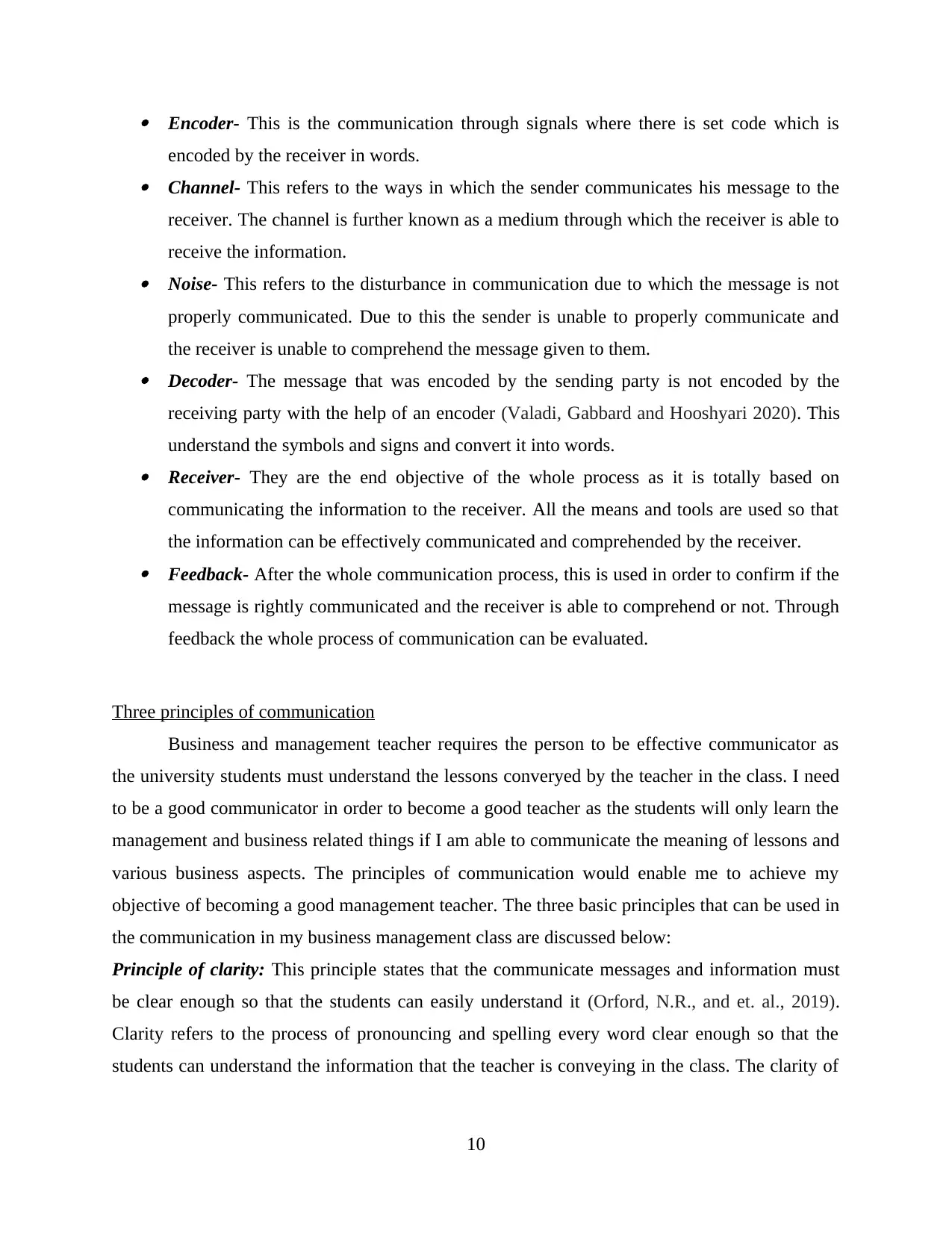
Encoder- This is the communication through signals where there is set code which is
encoded by the receiver in words. Channel- This refers to the ways in which the sender communicates his message to the
receiver. The channel is further known as a medium through which the receiver is able to
receive the information. Noise- This refers to the disturbance in communication due to which the message is not
properly communicated. Due to this the sender is unable to properly communicate and
the receiver is unable to comprehend the message given to them. Decoder- The message that was encoded by the sending party is not encoded by the
receiving party with the help of an encoder (Valadi, Gabbard and Hooshyari 2020). This
understand the symbols and signs and convert it into words. Receiver- They are the end objective of the whole process as it is totally based on
communicating the information to the receiver. All the means and tools are used so that
the information can be effectively communicated and comprehended by the receiver. Feedback- After the whole communication process, this is used in order to confirm if the
message is rightly communicated and the receiver is able to comprehend or not. Through
feedback the whole process of communication can be evaluated.
Three principles of communication
Business and management teacher requires the person to be effective communicator as
the university students must understand the lessons converyed by the teacher in the class. I need
to be a good communicator in order to become a good teacher as the students will only learn the
management and business related things if I am able to communicate the meaning of lessons and
various business aspects. The principles of communication would enable me to achieve my
objective of becoming a good management teacher. The three basic principles that can be used in
the communication in my business management class are discussed below:
Principle of clarity: This principle states that the communicate messages and information must
be clear enough so that the students can easily understand it (Orford, N.R., and et. al., 2019).
Clarity refers to the process of pronouncing and spelling every word clear enough so that the
students can understand the information that the teacher is conveying in the class. The clarity of
10
encoded by the receiver in words. Channel- This refers to the ways in which the sender communicates his message to the
receiver. The channel is further known as a medium through which the receiver is able to
receive the information. Noise- This refers to the disturbance in communication due to which the message is not
properly communicated. Due to this the sender is unable to properly communicate and
the receiver is unable to comprehend the message given to them. Decoder- The message that was encoded by the sending party is not encoded by the
receiving party with the help of an encoder (Valadi, Gabbard and Hooshyari 2020). This
understand the symbols and signs and convert it into words. Receiver- They are the end objective of the whole process as it is totally based on
communicating the information to the receiver. All the means and tools are used so that
the information can be effectively communicated and comprehended by the receiver. Feedback- After the whole communication process, this is used in order to confirm if the
message is rightly communicated and the receiver is able to comprehend or not. Through
feedback the whole process of communication can be evaluated.
Three principles of communication
Business and management teacher requires the person to be effective communicator as
the university students must understand the lessons converyed by the teacher in the class. I need
to be a good communicator in order to become a good teacher as the students will only learn the
management and business related things if I am able to communicate the meaning of lessons and
various business aspects. The principles of communication would enable me to achieve my
objective of becoming a good management teacher. The three basic principles that can be used in
the communication in my business management class are discussed below:
Principle of clarity: This principle states that the communicate messages and information must
be clear enough so that the students can easily understand it (Orford, N.R., and et. al., 2019).
Clarity refers to the process of pronouncing and spelling every word clear enough so that the
students can understand the information that the teacher is conveying in the class. The clarity of
10
Paraphrase This Document
Need a fresh take? Get an instant paraphrase of this document with our AI Paraphraser
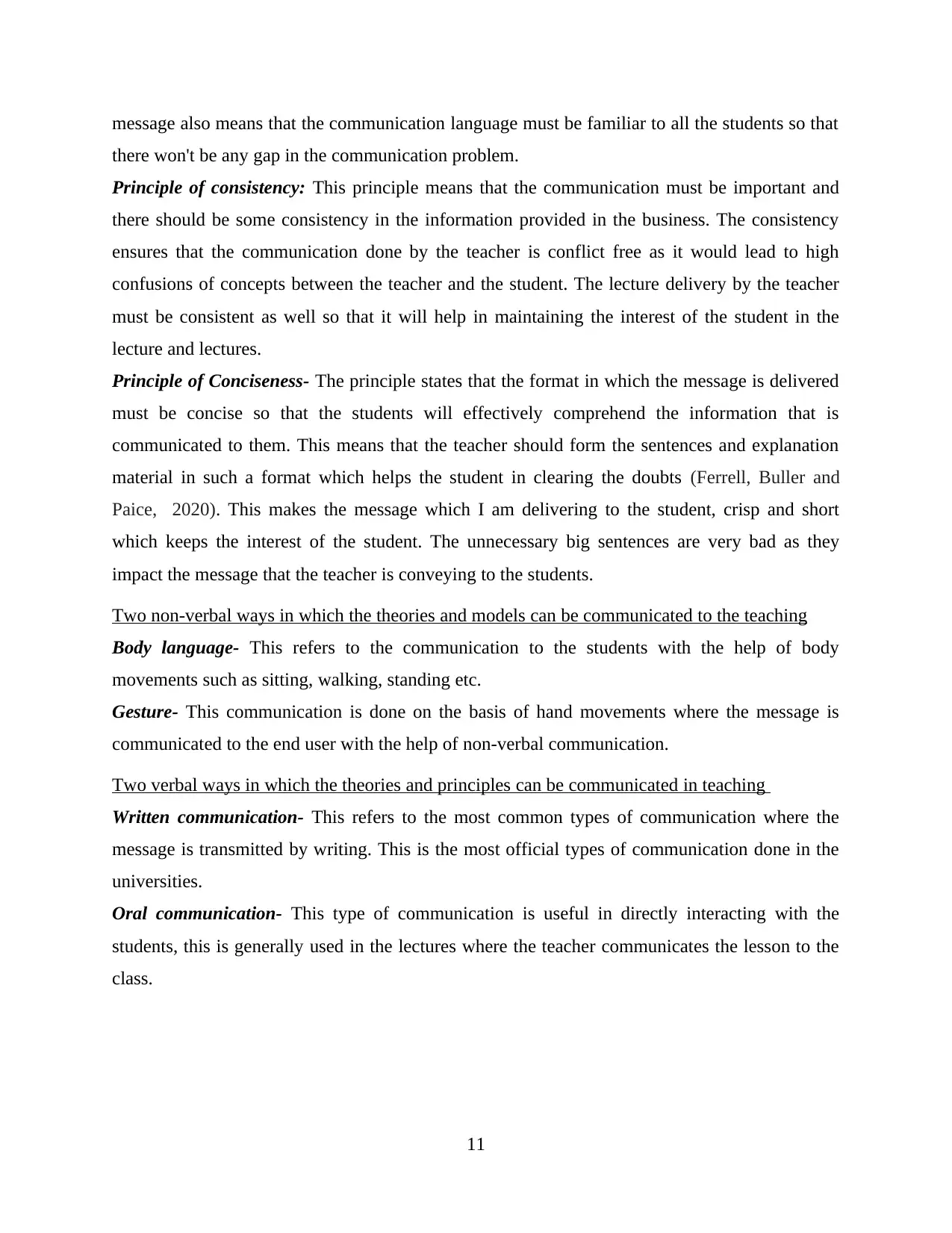
message also means that the communication language must be familiar to all the students so that
there won't be any gap in the communication problem.
Principle of consistency: This principle means that the communication must be important and
there should be some consistency in the information provided in the business. The consistency
ensures that the communication done by the teacher is conflict free as it would lead to high
confusions of concepts between the teacher and the student. The lecture delivery by the teacher
must be consistent as well so that it will help in maintaining the interest of the student in the
lecture and lectures.
Principle of Conciseness- The principle states that the format in which the message is delivered
must be concise so that the students will effectively comprehend the information that is
communicated to them. This means that the teacher should form the sentences and explanation
material in such a format which helps the student in clearing the doubts (Ferrell, Buller and
Paice, 2020). This makes the message which I am delivering to the student, crisp and short
which keeps the interest of the student. The unnecessary big sentences are very bad as they
impact the message that the teacher is conveying to the students.
Two non-verbal ways in which the theories and models can be communicated to the teaching
Body language- This refers to the communication to the students with the help of body
movements such as sitting, walking, standing etc.
Gesture- This communication is done on the basis of hand movements where the message is
communicated to the end user with the help of non-verbal communication.
Two verbal ways in which the theories and principles can be communicated in teaching
Written communication- This refers to the most common types of communication where the
message is transmitted by writing. This is the most official types of communication done in the
universities.
Oral communication- This type of communication is useful in directly interacting with the
students, this is generally used in the lectures where the teacher communicates the lesson to the
class.
11
there won't be any gap in the communication problem.
Principle of consistency: This principle means that the communication must be important and
there should be some consistency in the information provided in the business. The consistency
ensures that the communication done by the teacher is conflict free as it would lead to high
confusions of concepts between the teacher and the student. The lecture delivery by the teacher
must be consistent as well so that it will help in maintaining the interest of the student in the
lecture and lectures.
Principle of Conciseness- The principle states that the format in which the message is delivered
must be concise so that the students will effectively comprehend the information that is
communicated to them. This means that the teacher should form the sentences and explanation
material in such a format which helps the student in clearing the doubts (Ferrell, Buller and
Paice, 2020). This makes the message which I am delivering to the student, crisp and short
which keeps the interest of the student. The unnecessary big sentences are very bad as they
impact the message that the teacher is conveying to the students.
Two non-verbal ways in which the theories and models can be communicated to the teaching
Body language- This refers to the communication to the students with the help of body
movements such as sitting, walking, standing etc.
Gesture- This communication is done on the basis of hand movements where the message is
communicated to the end user with the help of non-verbal communication.
Two verbal ways in which the theories and principles can be communicated in teaching
Written communication- This refers to the most common types of communication where the
message is transmitted by writing. This is the most official types of communication done in the
universities.
Oral communication- This type of communication is useful in directly interacting with the
students, this is generally used in the lectures where the teacher communicates the lesson to the
class.
11
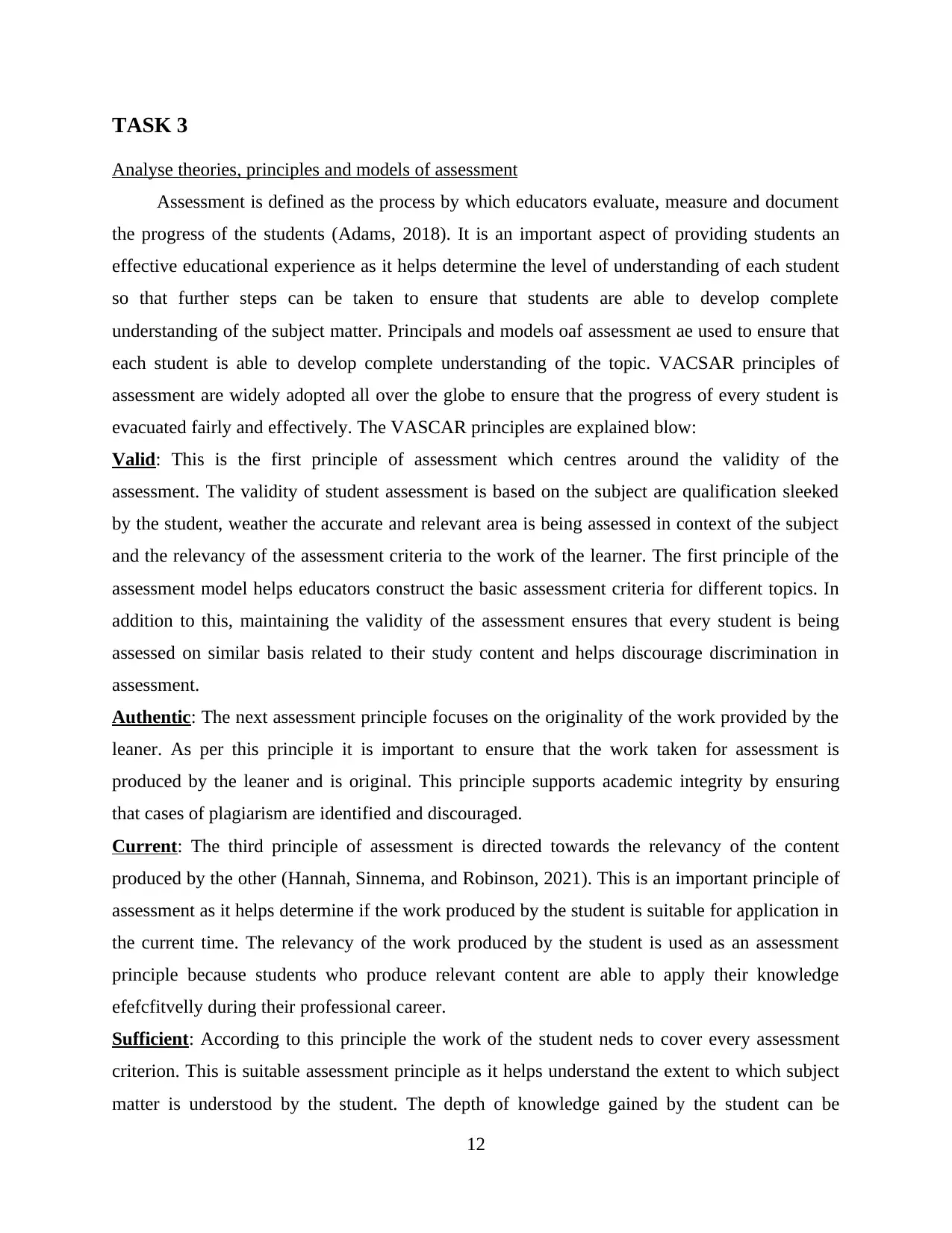
TASK 3
Analyse theories, principles and models of assessment
Assessment is defined as the process by which educators evaluate, measure and document
the progress of the students (Adams, 2018). It is an important aspect of providing students an
effective educational experience as it helps determine the level of understanding of each student
so that further steps can be taken to ensure that students are able to develop complete
understanding of the subject matter. Principals and models oaf assessment ae used to ensure that
each student is able to develop complete understanding of the topic. VACSAR principles of
assessment are widely adopted all over the globe to ensure that the progress of every student is
evacuated fairly and effectively. The VASCAR principles are explained blow:
Valid: This is the first principle of assessment which centres around the validity of the
assessment. The validity of student assessment is based on the subject are qualification sleeked
by the student, weather the accurate and relevant area is being assessed in context of the subject
and the relevancy of the assessment criteria to the work of the learner. The first principle of the
assessment model helps educators construct the basic assessment criteria for different topics. In
addition to this, maintaining the validity of the assessment ensures that every student is being
assessed on similar basis related to their study content and helps discourage discrimination in
assessment.
Authentic: The next assessment principle focuses on the originality of the work provided by the
leaner. As per this principle it is important to ensure that the work taken for assessment is
produced by the leaner and is original. This principle supports academic integrity by ensuring
that cases of plagiarism are identified and discouraged.
Current: The third principle of assessment is directed towards the relevancy of the content
produced by the other (Hannah, Sinnema, and Robinson, 2021). This is an important principle of
assessment as it helps determine if the work produced by the student is suitable for application in
the current time. The relevancy of the work produced by the student is used as an assessment
principle because students who produce relevant content are able to apply their knowledge
efefcfitvelly during their professional career.
Sufficient: According to this principle the work of the student neds to cover every assessment
criterion. This is suitable assessment principle as it helps understand the extent to which subject
matter is understood by the student. The depth of knowledge gained by the student can be
12
Analyse theories, principles and models of assessment
Assessment is defined as the process by which educators evaluate, measure and document
the progress of the students (Adams, 2018). It is an important aspect of providing students an
effective educational experience as it helps determine the level of understanding of each student
so that further steps can be taken to ensure that students are able to develop complete
understanding of the subject matter. Principals and models oaf assessment ae used to ensure that
each student is able to develop complete understanding of the topic. VACSAR principles of
assessment are widely adopted all over the globe to ensure that the progress of every student is
evacuated fairly and effectively. The VASCAR principles are explained blow:
Valid: This is the first principle of assessment which centres around the validity of the
assessment. The validity of student assessment is based on the subject are qualification sleeked
by the student, weather the accurate and relevant area is being assessed in context of the subject
and the relevancy of the assessment criteria to the work of the learner. The first principle of the
assessment model helps educators construct the basic assessment criteria for different topics. In
addition to this, maintaining the validity of the assessment ensures that every student is being
assessed on similar basis related to their study content and helps discourage discrimination in
assessment.
Authentic: The next assessment principle focuses on the originality of the work provided by the
leaner. As per this principle it is important to ensure that the work taken for assessment is
produced by the leaner and is original. This principle supports academic integrity by ensuring
that cases of plagiarism are identified and discouraged.
Current: The third principle of assessment is directed towards the relevancy of the content
produced by the other (Hannah, Sinnema, and Robinson, 2021). This is an important principle of
assessment as it helps determine if the work produced by the student is suitable for application in
the current time. The relevancy of the work produced by the student is used as an assessment
principle because students who produce relevant content are able to apply their knowledge
efefcfitvelly during their professional career.
Sufficient: According to this principle the work of the student neds to cover every assessment
criterion. This is suitable assessment principle as it helps understand the extent to which subject
matter is understood by the student. The depth of knowledge gained by the student can be
12
⊘ This is a preview!⊘
Do you want full access?
Subscribe today to unlock all pages.

Trusted by 1+ million students worldwide
1 out of 22
Related Documents
Your All-in-One AI-Powered Toolkit for Academic Success.
+13062052269
info@desklib.com
Available 24*7 on WhatsApp / Email
![[object Object]](/_next/static/media/star-bottom.7253800d.svg)
Unlock your academic potential
Copyright © 2020–2025 A2Z Services. All Rights Reserved. Developed and managed by ZUCOL.

